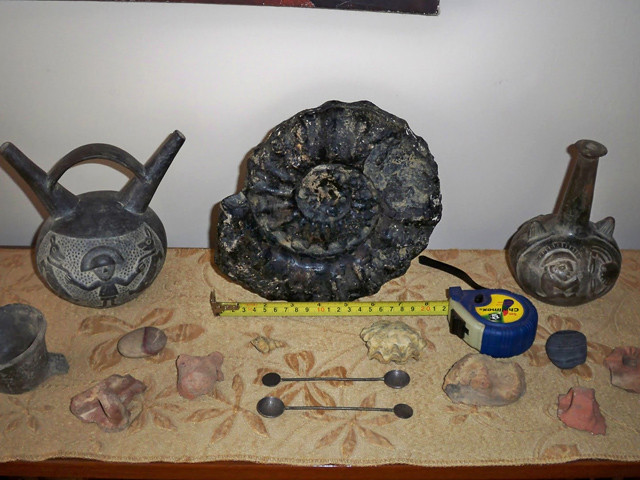Andean ammonite fossil – A 232.5 million year old mystery solved!
Several weeks ago family members who own a farm near the city of Jaèn were plowing a recently cleared plot of land to plant yuccas. The plow unearthed this oddity shown in the center of the photo. Knowing that I collect and have shelves of unusual things I’ve found, they brought the piece to Chiclayo as a Christmas gift for me. Opinions during a family discussion about what the object might be ranged from an octopus tentacle to a man-made artifact to a part left behind by alien visitors. To me it looked like a fossil of a giant snail, so that’s how I started my Google search.
Article brought to you by Mochica Hostess Tours
By Tom Filipowicz

It didn’t take many tries to learn that what I had was an ammonite fossil. These fossils are very common and are found all over the planet. The internet is loaded with photos like this one. They come in a variety of colors and sizes, but all have a typical snail shaped shell mostly with ribbed segments, though they were related closer to octopuses and squids than their shelled relatives. Black ammonites are of the species Asteroceras Obtusi.
Ammonites first show up in the fossil record about 400 million years ago. Fossils have been found in Huancayo Peru dating back 350 million years, and in other parts of Peru to 150 million years. The species went extinct at the same time as the dinosaurs, about 65 million years ago.
So the newest and most senior member of my oddity collection is an ammonite fossil dating back 232.5 million years, give or take 167.5 million years. Almost makes me feel young again
If you’d like to experience places like this and get a taste of real daily life in northern provincial Peru, speak to Tom & Maribel via Mochica Hostess Tours







![Novalima in London [Featured]](http://farm3.static.flickr.com/2311/1508319950_4fede310ba_m.jpg)


